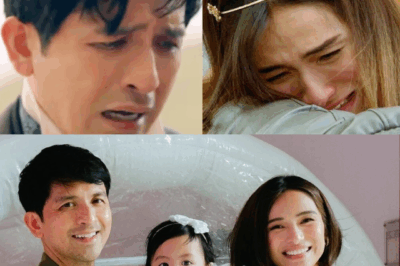He was born into a family of statesmen, but his heart was never in politics. Instead, Victor “Cocoy” Laurel carved a path uniquely his own — one lined with music, color, and soul. The name Laurel may have echoed through the halls of government, but Cocoy made it resound on the stage, in song, and on canvas.
And now, at 72, that voice has gone silent. But what a melody he left behind.
Born on March 2, 1953, Cocoy was the eldest son of former Philippine Vice President Salvador “Doy” Laurel and celebrated painter-actress Celia Diaz Laurel. It was no surprise he grew up steeped in culture, yet burdened by expectations. Shy, often bullied, and reluctant in the public eye, young Cocoy found refuge in creativity. It wasn’t the podium that called to him — it was the stage.
At just 15, he was crowned “Romeo of the Philippines” after a national talent search, his natural charm and artistic flair already evident. But he wanted more. He left the country to study in Spain, then New York. Portraiture in Madrid, acting in the American Academy of Dramatic Arts, and music at Juilliard — few knew just how much he sacrificed to master his craft.
He returned a young man not just hungry for applause, but deeply committed to artistic truth.
In the 1970s, he starred alongside Nora Aunor in “Lollipops and Roses,” captivating audiences with his subtle intensity and unmistakable warmth. Films like “Disco Fever,” “Impossible Dream,” and “Pinoy American Style” soon followed. He had the look of a matinee idol, but his heart beat strongest on the stage.
With Repertory Philippines, Cocoy blossomed — West Side Story, Sweeney Todd, Fiddler on the Roof. His performances were layered, vulnerable, human. Then came Miss Saigon.
Cocoy joined the original London cast as Assistant Commissar and later took on the demanding role of The Engineer in the Australian tour, performing more than 450 shows. It was an artistic triumph. He had gone global — but never abandoned home.
In 1996, he returned to the Philippines to portray national hero Dr. José Rizal during a historical reenactment. The audience watched in silence as Cocoy, in full costume, relived the final moments of the country’s most revered martyr. For him, art was always in service of something greater — memory, truth, identity.
But behind the spotlight, Cocoy battled quietly.
In 2005, during a musical performance, he suffered a severe spinal injury. Surgery followed. Pain became his shadow. Then came a near-deadly ulcer and another hospitalization in 2007. The man once known for his energetic stage presence now moved slower, with a cane, and sometimes — with help.
He never complained.
Instead, he painted. His art shifted from vibrant performance to introspective brushstrokes. His portraits grew deeper, eyes more soulful. He sang in church choirs. He taught. He mentored. Even in silence, Cocoy communicated.
In April 2025, he made a rare public appearance — at the wake of his dear friend, Nora Aunor. The actress who once held his hand on screen now lay still, and Cocoy honored her the best way he knew: he painted her portrait. It was haunting, beautiful, and filled with reverence. Few knew he was grieving another loss — his own sister, Suzie Laurel, had just passed away.
Weeks later, Cocoy would follow them.
On June 14, 2025, Victor “Cocoy” Laurel died at the age of 72. The cause: cardiac arrest due to multiple organ failure. It was sudden for the public, but not for those closest to him. He had been fading, gently, privately. As he lived, so he left.
No fanfare. No headlines. Just silence.
But tributes poured in — from former co-stars, students, family, fans. They spoke of his generosity, his discipline, his quiet humor. “He never chased fame,” one colleague said. “He chased meaning.”
Cocoy Laurel’s life was not one of screaming spotlights or scandal. It was a story of consistency, of humility, and a passion so profound that it never needed to shout. He embodied an era of Filipino theater that was honest and unafraid, when every lyric was a confession and every gesture — a promise.
He leaves behind not just roles, but impact.
To those who saw him as The Engineer, he was unforgettable. To those who watched him paint, he was a philosopher. To those who called him friend, he was family. And to the nation, he was a quiet genius.
His absence now leaves a stillness. But in that stillness, echoes of his voice remain — in the songs he sang, the portraits he painted, the stories he told.
And maybe that’s how he wanted it.
No farewell speeches. No long goodbyes. Just a life well lived… and a legacy whispered in the wings.
Victor “Cocoy” Laurel has taken his final bow. But the curtain hasn’t closed — because legends never really leave. They live on in every note, every scene, and every heart they’ve ever touched.
News
New Life Abroad? Kathryn Bernardo Allegedly Moving In With Mayor Mark Alcala in Australia
It started as just another rumor—until it didn’t. Fans of Kathryn Bernardo were left stunned as news began to circulate…
Dennis Trillo Breaks Down Over What Happened to Jennylyn Mercado’s Son with Patrick Garcia
Dennis Trillo has always been known as one of the most composed and private actors in showbiz. Calm, respectful, and…
Annabelle Rama Slams Barbie! Richard Gutierrez’s Breakup Linked to Third Party and Albay Exit
It was a storm no one expected, but now that it’s here—everyone’s watching. In what began as quiet speculation and…
Paulo Avelino Breaks Silence: Why He Held Back from Janine Gutierrez
For years, their names were linked by something electric yet invisible—Paulo Avelino and Janine Gutierrez, two stars whose chemistry burned…
Marian vs. Karylle? Heated Scene Between Actresses Goes Viral—What Really Happened?
What was meant to be a glamorous event quickly turned into one of the most talked-about showbiz moments of the…
Trouble at Home? Kathryn Bernardo Reportedly Leaves After Mommy Min Disapproves of Mark Alcala
In a shocking twist that has sent waves across the fandom, reports are now surfacing that beloved actress Kathryn Bernardo…
End of content
No more pages to load












